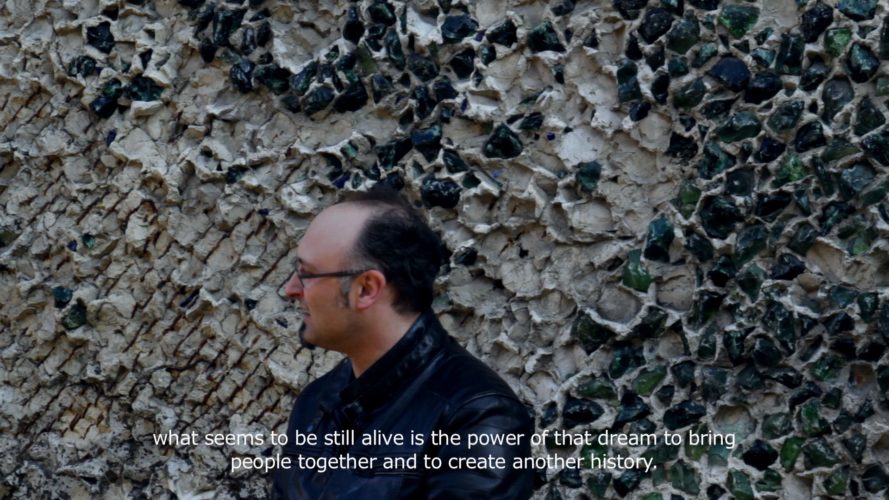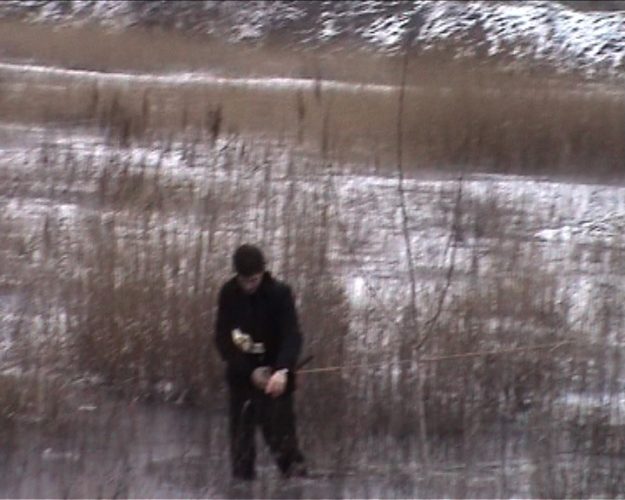“All elements of re-modernization notwithstanding, whether through industrialization or even financialization, the fact is that the real socialism introduced into the consciousness of people, into their local histories, a period of divergence from the unique thread of Western modernity, which was to define the sense of the world. An entirely different history of world was about to be written.”
– Ovidiu Țichindeleanu in the video Gagarin’s Tree (Mona Vătămanu & Florin Tudor, 2016)
Athens! It was an instant association that came to my mind when I first walked through the streets in the center of Bucharest. Both of these cities are linked by the color of the sidewalks and the advertising spaces on the facades of the houses. In summer, there may even be similar chaos here. It might have also been the tarnished plaster or a certain atmosphere, perhaps the type of plants in the parks, or it was simply because Athens was in the air in June. Anyway, it was the first city I immediately compared with Bucharest. Otherwise, these are entirely different places. While Athens, thanks to Documenta, has been at the heart of the world’s art scene, Bucharest is at its very edge. Even though the Romanian capital can boast a diverse institutional infrastructure – largely under the auspices of the Union of Romanian artists – and several internationally renowned artists, Bucharest’s streets remain in the shadow of Eastern Europe and its (perhaps emancipatory) globalization process.
In order to focus at least partially on the Bucharest scene, I have chosen one segment that I focused on: artistic videos. Of course I did not see all the Romanian production in two weeks, rather I followed the names of the artists that someone wrote to me on a piece of paper in haste. Then, I have selected authors who work with documentary techniques from these lists, because it is the theme of long-term research in the etc. gallery in Prague, where I work. I did not care about what is contemporary and what is progressive. I was looking more at answering the question of how Bucharest escapes the imagination of the West and how the global visual language is portrayed in Romanian videos.
Documentarism in video-art is historically dated to the second half of the 1990s and to the turn of the 20th and 21st century. Specific conditions of the period led to an effort to define and update the position within the division of the Euro-American space to East and West after 1989 and to the need to respond to the growing global crisis. This was also associated with distrust in the objective representation of political events and the increasing power of the mass media. Documentary forms and the investigation of the processes of truth and reality fabrication have culminated in Documenta 11 (2002) and during the following years, in the works of Hito Steyerl, Omer Fast, Artur Żmijewski, Big Hope art collective and others.
Documentarism of the 1990s and the first decade of the 21st century centered mainly on the reflection of historical conditions and the processes of displaying reality through the video format. Eventually, the attention turned to the recording apparatus itself – the camera. Also noteworthy are the authors who had started to stand behind the apparatus and stepped into the picture themselves. The direct performativity of the creator’s body, which visibly engages the relationship between the viewer and the documented reality, has become another strategy to draw attention to the artificialness of the presented narrative. It shows how inadequate are the strategies used so far, in which the viewer himself relies on the presented reality.
Hito Steyerl or Rabih Mroué are among such artists who intervene with the knowledge that it is not enough to let the documentaries speak for themselves. Their lecture–performances, which describe the events captured in the paintings and focus primarily on the influence of these images in perceptual processes, are now closer to the theater than to the situation of the video in the gallery environment.
It is not easy to describe what is hidden under documentarism as such. On the one hand, documentary strategies have begun to imprint on the works of art themselves, without actually being able to label them for documentary works, and on the other hand, what we perhaps consider to be “documentary” is changing rapidly. Today we are talking about reality, and tomorrow someone will call it a fiction. Similarly, it is necessary to approach specific historical contexts, which can often appear gradually, fragmentarily and chaotically.
The video Palatul (2003-2004) from Mona Vătămanu and Florin Tudor, which actually consists of two different records of the same situation, shows it well. Both screens, which are ideally installed side by side, run the recordings made from two tours of the Parliament Palace, iconic building that, although quiet and deserted, conceals all the weight of the past. Each video, however, records another guide, who, in their various narratives, attitudes and ways that represent the corridors of the palace, form a brilliant juxtaposition. Thus they deny each other and confirm the “Rashomon principle” – referring to the classical film by Akira Kurosawa – which illustrates the unreliable nature of the narrative. The truth lies perhaps somewhere in the middle, but under the heavy sediment of discourses, where the two guides move and which is the base for their talk. It shows here that there is a close connection between history and narrative – just as it is in Italian, which has the same word for history and story: storia.
In the videos, Vătămanu and Tudor used a hidden camera – they have filmed the guide in secret to keep the viewer as close as possible to the experience the tourists have while they pass through the corridors and admiring the rich interior of the palace. The hidden camera bestows authenticity to the shots, the focus here is more on the guide than on the way of filming. Irina Botea Bucan works with a similar motif in the half-hour video Film Postale (2013), a collaboration with Nicu Ilfoveanu. Here he depicts three guides from three different memorable houses. The author asked them to speak in front of the camera, and captured each such “performance” in a home-museum environment in a different way on the camera. Somewhere she puts more emphasis on sound, elsewhere on the picture and the atmosphere.
Also her video Picturesque (2013) has a quasi-documentary touch. Its main protagonist is a writer giving the author a tour on the Romanian countryside and telling her the fate of a place abandoned by people. Besides the landscape itself, attention is paid to the question of What is beautiful? What is picturesque? And how can these categories be judged in relation to the image we see before our eyes, and to the narrative that comes from the mouth of the old writer. Botea Bucan explains the image framing process in an extended interpretation – here a hint of interest in the formal aspects of documentary strategies and the attempt to analyze the modes of representation and their influence on the construction of knowledge can be seen. Still, the whole video is dominated by a very classic documentary camera, and the story is mainly made by a “talking head”. Botea Bucan works with other documentary strategies in her videos as well: with a reenaction (Auditions for a Revolution, 2006) or with repetitions. Similar procedures would be found with Mona Vătămanu and Florin Tudor, although the styling features of their videos are quite different.
Dan Acostioaei works with a different local history in his videos – this time with the forms of transformation of Romanian society and its economic infrastructure. We can find the thematization of personal history and our own body with a young artist, Alexandra Ivanciu, whose diploma work on women missing from the canon of art history I regrettably missed. One, however, has most of the videos I have had the opportunity to see in common: it is a frame of narration, history and its relationship to the present through the unreliable flow of stories. Emphasis is placed primarily on what is going on in front of the camera, mostly lacking the criticism of the media itself, and the visuality of the video is somewhat outdated or even conservative. Perhaps this can be assessed positively – it is difficult to determine any assessment criteria in this case and to avoid parallel with the artistic production of the West.
The words of philosopher Ovidiu Țichindeleanu quoted in the introduction to this text sound in the Gagarin’s Tree (2016) video by Vătămanu and Tudor. The central theme of this work is the question of what of the past, which the post-communist society has rejected, had persisted, and how to read the fragments and ruins that speak to us in the language of the previous regime. The video of Gagarin’s Tree is an iconic example of a complicated and paradoxical reflection of the Eastern European region. In two years it will be thirty years since the iconic year of 1989, that did not mark the beginning of creating a connected and united world, as was expected, at all. Romanian video artists – and it is best shown in the works that deal with documentary material – are undergoing a phase of self-reflection in relation to their own local history. That is why so much attention is devoted to places connected with the Communist regime, but also to other recent events.
Boris Buden, who considers “historical amnesia” to be characteristic of the situation in post-communist Eastern Europe, borrowed a story from Romania in his book Zone des Übergangs: Vom Ende des Postkommunismus to illustrate this. According to Buden, in the first days of the Romanian Revolution, the ideological symbol of communism was cut off from the national flag and the flag was worn like this for a while. The Romanian artists I met during my residence struggle with this – trying to get back to the moment of the cut and to understand it. They do so by exploring their own personal or local history. This is the reason why they do not have a stronger global appreciation and understanding – it is very difficult for their specific stories to be translated into a different language or context. And although European art institutions are now much better interconnected and East and West art works migrate across the world, the canon of art is still created through Western discourse. This was also evident at this year’s Documenta: what, after all, was the focus of attention? The Athenian scene and its artistic infrastructure or the gesture of critical neo-colonialism introduced by Kassel?
Anna’s residency in Bucharest was made possible with the generous support of AFCN, the Czech Centre in Bucharest and ICR Prague.
POSTED BY
Anna Remešová
Anna Remešová (b. 1990) is based in Prague and works as a curator in Etc. Gallery, editor for the online art magazine Artalk.cz and coordinator of the project UMA Audioguide. She contributes to vari...
www.artalk.cz








Comments are closed here.